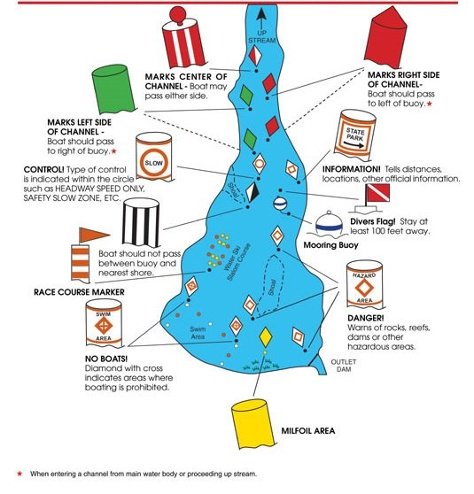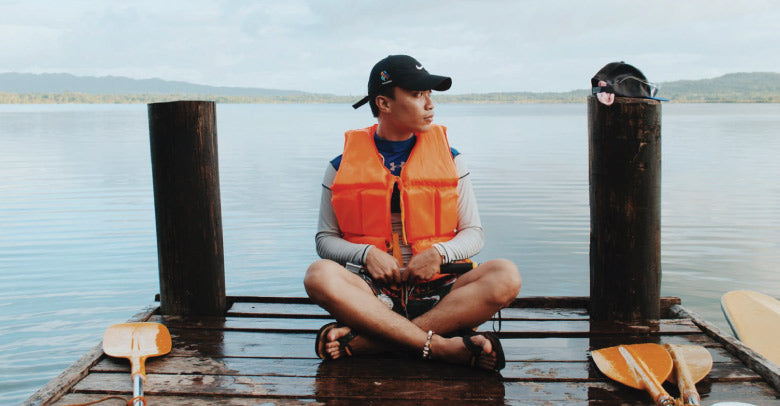Boating safety should be every boater’s priority, whether it’s just you on the water or a group of family and friends. You never know what could go wrong, so it’s essential for you and your guests to be prepared in case of an emergency. Being prepared before departure will help minimize risk, injury, and damage. We have put together a list of boating safety basics to help you to think about numerous safety factors including:
- Before Departure
- The Dock
- Severe Weather
- Markers & Symbols
This article only touches on the basics of boating safety. We encourage you to consult your owner’s manual for the boat & engine as well as local, state, and national resources. A great first starting point is your local US Coast Guard Auxiliary. You can receive training and boat inspections among other services offered, www.cgaux.org.
Before Departure
-
This is going to sound very basic but, learn to swim. Being on and around boats means that at some point you will fall in the water and might not have your life jacket on. There are many local organizations that offering swimming lessons. Have fun and gain confidence.
-
Check the weather and if applicable tide reports seeing if there are any conditions of which you should be aware.
-
Make sure you have all the necessary paperwork/documentation on hand. This includes your boater safety license (if required), some form of government-issued picture ID, and the boat’s registration.
-
Have at least one life jacket onboard for each person who will be on the trip. Make sure everyone has a life jacket that properly fits. If it does not fit, it does not count as a life jacket for that person and you are in violation. Life jackets should be in good condition and in an easily accessible location. Note: many states have laws for mandatory wearing of life jackets for children of certain ages. Familiarize yourself with these and other boating-related laws.
-
Be sure to have a throwable floatation device, oar(s), and visual distress signals on hand in case of an emergency. If using flares for a visual distress signal, check the expiration date. If they are expired, you are in violation.
-
Fire extinguishers should be quickly accessible and in working condition. Make sure your fire extinguisher is not expired. Check the date! If it is expired, you are in violation.
-
Test that the horn and compass are working. We like to recommend an additional non-electronic noisemaker such as a whistle or hand-powered style horn. In case you have lost battery power, it is imperative to be able to make noise at the appropriate time. It can save you from an accident or direct help to you where visual recognition is impeded or impossible. If you can’t be seen, BE HEARD!
-
Check your fuel levels and that you have enough fuel for your trip. Part of your “before you go boating check” is a review of the boat. Make sure you do not detect any strong fuel smells in the air. If you do, it could be indicative of a leak.
-
Test the navigation lights for functionality.
-
File a float plan. Let someone on land know exactly where you are going, who’s going, and for how long.
The Dock - Leaving / Arriving
-
Have a designated helper who is also familiar with boating safety and operations.
-
Position your fenders properly outside of the boat just before arrival. After leaving the dock, properly stow the fenders inside of the boat.
-
Dock Lines - understand if the line stays on the dock or comes with the boat. Stow lines in either case appropriately so they are not a trip hazard or blow off/out.
-
Advise your passengers to keep their arms and hands inside the boat at all times.
-
Verify that all applicable life jacket laws are observed while on the water.
-
Be alert at all times of other nearby people, boats, and wildlife.
-
Proceed slowly. We at PartsVu have a saying, “Only go as fast as you want to hit the dock." Very few docking situations require strong thrust to dock. Go slow.
Managing Severe Weather
-
In today’s wired world, there are many mobile devices, onboard GPS devices, and others that have weather apps/functionality to stay on top of a dynamic weather day.
-
If severe weather arrives, reduce speed, keeping just enough power to maintain headway. In many cases, visibility is greatly reduced.
-
Assure all passengers are wearing a life jacket. Severe weather can quickly bring dynamic situations diminishing any time to put on a life jacket. For your safety, put them on.
-
Turn on your running lights.
-
If possible, head for the nearest shore/dock that is safe to approach.
-
Keep the bilges free of water.
-
Seat any passengers on the bottom of the boat, near the centerline, and when applicable near the transom back of the boat. Remember to maintain a balanced load under all conditions; even more so with severe weather.
-
If the engine fails, trail a sea anchor from the bow of the boat to keep the boat headed into the waves.
-
Anchor the boat into the tide or wind whichever is greater (and this can change - stay alert) when it makes sense and is possible. You must decide based upon a number of criteria if it is best to ride out the storm or to get underway to land/dock. We recommend taking boating courses provided by the USCG Auxiliary, Click for Courses.
SEE ALSO: MUST HAVE BOAT ELECTRONICS FOR NAVIGATION, SAFETY, & FUN
Navigation Markers & Symbols
Be familiar with the orange-and-white markers that are used to alert boat operators to the channel “road” so you do not run aground or afoul other navigation hazards. They also provide various warnings. The signs can be floating or fixed generally on a piling for intracoastal boating.


If you follow these basic guides, you should be able to enjoy safe and smooth sailing. To learn more about boat safety and increase your confidence on the water, you can always enroll in a local course. Check out the U.S. Coast Guard Boating Safety Division’s approved list of courses here. Did you know the Coast Guard also offers free Vessel Safety Checks? Find out how you can schedule your boat’s safety check here.














